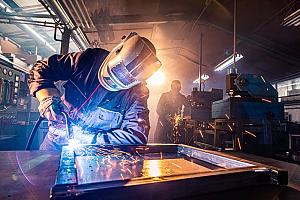- FMA
- The Fabricator
- FABTECH
- Canadian Metalworking
Categories
- Additive Manufacturing
- Aluminum Welding
- Arc Welding
- Assembly and Joining
- Automation and Robotics
- Bending and Forming
- Consumables
- Cutting and Weld Prep
- Electric Vehicles
- En Español
- Finishing
- Hydroforming
- Laser Cutting
- Laser Welding
- Machining
- Manufacturing Software
- Materials Handling
- Metals/Materials
- Oxyfuel Cutting
- Plasma Cutting
- Power Tools
- Punching and Other Holemaking
- Roll Forming
- Safety
- Sawing
- Shearing
- Shop Management
- Testing and Measuring
- Tube and Pipe Fabrication
- Tube and Pipe Production
- Waterjet Cutting
Industry Directory
Webcasts
Podcasts
FAB 40
Advertise
Subscribe
Account Login
Search
Sponsored Content
The Why, What, and How of Precision Sheet Metal Automation
Automation Talk takes a deep dive into the industry's technology trends
- Updated May 29, 2024
- July 1, 2024
- Article
- Automation and Robotics
Think automation and flashy robots—traditional as well as collaborative, stationary and mobile—usually come to mind. Autonomy comes to mind too, especially valuable in high-product-mix manufacturing. The smarter automation becomes, the more useful it can be, and the greater the labor savings, allowing metal manufacturers big and small to compete with the world.
That said, the industry’s automation story is full of subtle complexities. In fact, according to a recent survey, more fabricators choose to automate not to save labor costs but instead to increase throughput. Customers are looking for fabricators who can ramp up and down in sync with customer demand, and the right automation strategy helps them do just that.
Automation also is helping fabricators shape new kinds of business models, ones that happen to attract smart and engaged people—experts that can manage advanced technology and think holistically about the enterprise, from how work is presented on the floor to how orders are processed in the office.
That is “the why” behind industry’s automation push.
What is being automated? Broadly speaking, fabricators are at three distinct levels. The first level is machine-based. Do a time study by a laser, a punch press, a press brake, or a welding cell, and you will often find that even the most engaged people spend their days doing anything but producing actual parts. They are not lazy, just doing their best with the technology they have.
The first level of automation aims to minimize or eliminate those nonvalue-adding tasks. Today’s panel benders are prime examples. Instead of switching out tools and running test parts on a brake, they call up a program, place a blank in the work envelope, initiate the program, and the machine does the rest. The machine sets up itself, and a manipulator moves the blank between bends. The operator then removes and stacks the work.
The second level incorporates material handling automation, with robots or conveyors feeding the machine and removing and stacking finished pieces. The third level expands automated material handling further up and down the value stream. And as fabricators advance up the levels of automation, every move that operator makes adds more value.
That is “the what” behind automation.
What has stopped fabricators from advancing up the levels? Much of it has to with the product mix. Early forms of manufacturing automation required some heavy lifting on the front end. Entire production lines were designed to run specific parts or assemblies, and even minor changes required monumental effort.
Software has changed the game. IIoT (industrial internet of things) platforms are tracking asset utilization, and offline programming and scheduling has automated much of what used to be hours or even days’ worth of tedium performed by engineers and technicians in the office.
Software shows the minutiae of every job and simulates to verify its manufacturability. Myriad details, from slat positions in relation to cut lines on the laser, to bend allowances produced on the panel bender, to the impact of holes and other features near bend lines or blank edges. All this lifts engineers “out of the weeds,” allowing them to focus on what truly adds value. They are not altering radii, moving a cutout slightly, or otherwise manually inputting job data into a disconnected system. Instead, they think about new ways to produce a sheet metal part or assembly—approaches that could shave hours, days, or even weeks off the production schedule.
That is “the how” behind automation, and as technologies like artificial intelligence and machine learning continue to advance, “the how” of software-driven automation will become more powerful than ever.
For a deeper dive, check out Automation Talk, a video series made in partnership with Salvagnini America.
Related Companies
subscribe now

The Fabricator is North America's leading magazine for the metal forming and fabricating industry. The magazine delivers the news, technical articles, and case histories that enable fabricators to do their jobs more efficiently. The Fabricator has served the industry since 1970.
start your free subscription- Stay connected from anywhere

Easily access valuable industry resources now with full access to the digital edition of The Fabricator.

Easily access valuable industry resources now with full access to the digital edition of The Welder.

Easily access valuable industry resources now with full access to the digital edition of The Tube and Pipe Journal.
- Podcasting
- Podcast:
- The Fabricator Podcast
- Published:
- 07/02/2024
- Running Time:
- 66:34
Desirée Guzmán, a welding instructor with Chicago Women in Trades (CWIT), joins us to talk about her full-circle...
- Trending Articles
Launching a career in metal fabrication and the skilled trades

Customer service a key for both traditional, e-commerce fab businesses

Automating spot welding to win fabrication work, maintain culture

Tips for planning a product development project

Feintool expands in Tennessee

- Industry Events
Precision Press Brake Certificate Course
- July 31 - August 1, 2024
- Elgin,
Laser Welding Certificate Course
- August 6 - 8, 2024
- Farmington Hills, IL
Golf 4 Manufacturing
- August 19, 2024
- Waukegan,
The Fabricator's Technology Summit
- August 20 - 21, 2024
- Eglin, IL



























